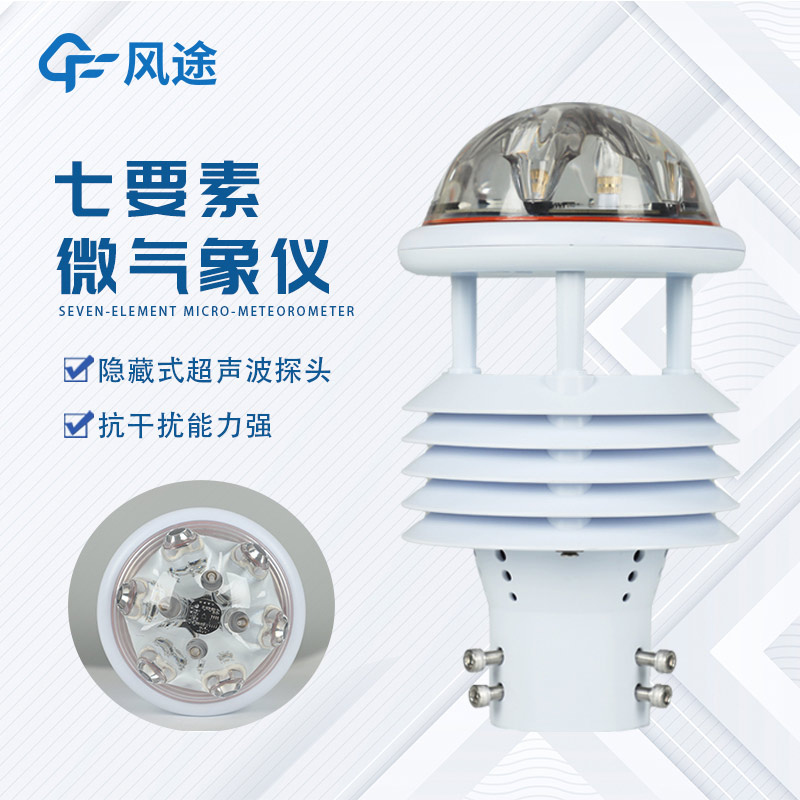Tianyi Sensor IOT Technology Co., Ltd
Sales Manager:Ms. Emily Wang
Cel,Whatsapp,Wechat:+86 15898932201
Email:info@fengtutec.com
Add:No. 155 Optoelectronic Industry Accelerator, Gaoxin District, Weifang, Shandong, China

Sales Manager:Ms. Emily Wang
Cel,Whatsapp,Wechat:+86 15898932201
Email:info@fengtutec.com
Add:No. 155 Optoelectronic Industry Accelerator, Gaoxin District, Weifang, Shandong, China
time:2025-06-23 09:06:06 source:Weather Station viewed:126 time
The 7-element miniature sensor includes monitoring modules for temperature, humidity, air pressure, illumination, wind speed, wind direction, etc., with a mounting bracket customized according to the street lamp structure. It can be installed at a rain-proof and ventilated position in the upper middle part of the street lamp pole. The sensor array is horizontally fixed by an L-shaped metal bracket to ensure that the wind speed and direction sensors are not blocked by the pole, and the illumination sensor faces the sky without obstruction. The collector can be designed as a waterproof metal box, installed near the maintenance port in the middle of the pole, with a main control chip, data storage module and communication unit integrated inside, connected to each sensor of the miniature sensor through waterproof cables, and the cables run inside the pole to avoid external damage.
The street lamp is powered by an AC 220V circuit. An independent branch is led out from the street lamp control box to supply power to the collector, and a lithium battery is configured inside the collector as a backup power source to cope with the power outage scenario during street lamp maintenance. For street lamps without mains access in remote areas, a small solar panel (with a power of about 50W) can be installed on the top of the pole, matched with a 12V energy storage battery, and the charge-discharge management of solar energy and the battery is realized through an MPPT controller.
The main control chip of the collector (such as the STM32 series) communicates with each sensor through an RS485 interface, collects raw data at a set frequency (recommended 10 seconds/time), and then stores it in a local SD card. The communication module can be selected according to the application scenario: 4G/5G wireless modules can be used for urban road street lamps to transmit data to the cloud server in real time; LoRa or NB-IoT networks can be deployed in closed scenarios such as industrial parks to reduce power consumption and transmission costs. An Ethernet interface is reserved for direct connection via network cable to configure parameters during on-site debugging. The collector needs to support the breakpoint resume function, automatically caching data when the network is interrupted and retransmitting it to the server after recovery.
When developing the collector firmware, it is necessary to be compatible with the communication protocol (such as Modbus RTU) of the miniature sensor, and implement data parsing, calibration and packaging in the main control program. The cloud platform can use the MQTT protocol to receive data, and the collector, as a client, regularly publishes JSON format data packets (including device ID, collection time, seven-element data, etc.) to the server topic. To facilitate the integration of the street lamp management system, API interfaces need to be opened to support third-party platforms to retrieve real-time data or historical records through the HTTP protocol. A Web management page is configured locally on the collector, and device status can be viewed and sampling frequency and other parameters can be modified by accessing it through a browser, without the need to install additional client software.

Hydrological flow monitoring equipment plays a crucial role in water conservancy work, helping us grasp the dynamics of water resources and facilitating flood control, water dispatch, and other tasks. Below is a detailed introduction to common equipment.Water Level Monitoring StationThe battery-powe...
TianYi® EL Detector [Model: FT-EL1] Partial Parameters:Detectable Defect Types: Cracks, broken cells, fragments, broken grids, black core, poor soldering, process contamination, low-efficiency cells, black edge, over-firing, over-etching, perforations.Camera: 20-megapixel; Resolution: 4...
In daily life, whenever we easily press the switch and the lights turn on instantly and the electrical appliances operate smoothly, few people will think deeply that behind this seemingly ordinary power supply, there is actually a huge and complex technological system operating stably. Among the man...
In the daily operation and maintenance of photovoltaic power plants, testing equipment is a key tool to ensure power generation efficiency and system stability. Among them, the EL detector and I-V Curve Tracer are two widely used professional devices that evaluate the performance of photovoltaic mod...